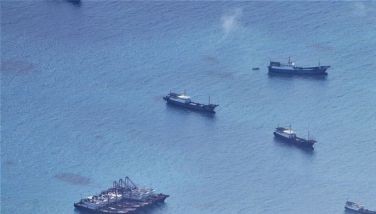Phivolcs to help RP neighbors in tsunami monitoring
June 17, 2006 | 12:00am
The Philippine Institute of Volcanology and Seismology (Phivolcs) will offer help to its neighbors in monitoring tsunamis, officials said yesterday.
Phivolcs Director Renato Solidum Jr. said they will provide countries like Taiwan, Japan and Australia with the country’s expertise and help with public education in "mapping an adaptation community" regarding tsunamis.
"The Taiwan government is being supported by the Philippines," Solidum said at a press briefing at the Trader’s Hotel along Roxas Boulevard, Manila. "Phivolcs is assisting the Asian Disaster Preparedness Center for the setup of tsunami and other hazard early warning system to be based in Bangkok, Thailand."
Phivolcs will guide the country’s neighbors "in their planning (and) we will maintain sea-level monitoring stations," he said.
Solidum said the Phivolcs will set up sensors to monitor seismic activity that might occur in a given Southeast Asian country. Tsunamis are usually spawned by undersea earthquakes.
"Some tsunamis that might occur in the South China Sea will come from our country, so we are worried about the tsunami export that we will provide them," Solidum said.
The Phivolcs will provide data to Tokyo and Australia through already existing volcanic ash advisory centers that cover Asia.
The tsunami spawned by the undersea Sumatra-Andaman earthquake in the Indian Ocean on Dec. 26, 2004 swept across South and Southeast Asia leaving 229,866 people lost — 186,983 declared dead and 42,883 listed as missing.
The epicenter of the earthquake was off the coast of Sumatra, Indonesia, one of the countries hardest hit by the tsunamis spawned by the tremblor that spread throughout the Indian Ocean, killing large numbers of people there and in Sri Lanka, India, Thailand and Myanmar, where 400 to 600 more people were believed to have perished. Tsunamis spawned by this undersea earthquake traveled as far as Port Elizabeth, South Africa — 8,000 kilometers from the earthquake epicenter — where the huge waves caused serious damage and killed one person.
At 9.3 on the Richter scale, the Sumatra-Andaman earthquake is the second largest earthquake ever recorded on a seismograph.
According to the Wikipedia online encyclopedia, "this earthquake was also reported to be the longest duration of faulting ever observed, lasting between 500 and 600 seconds, and it was large enough that it caused the entire planet to vibrate at least half an inch, or over a centimeter. It also triggered earthquakes in other locations as far away as Alaska."
The plight of the many people and countries affected by the 2004 tsunami prompted a widespread humanitarian response with the worldwide community donating over $7 billion in humanitarian aid to those affected by the earthquake and the tsunamis it spawned.
Phivolcs Director Renato Solidum Jr. said they will provide countries like Taiwan, Japan and Australia with the country’s expertise and help with public education in "mapping an adaptation community" regarding tsunamis.
"The Taiwan government is being supported by the Philippines," Solidum said at a press briefing at the Trader’s Hotel along Roxas Boulevard, Manila. "Phivolcs is assisting the Asian Disaster Preparedness Center for the setup of tsunami and other hazard early warning system to be based in Bangkok, Thailand."
Phivolcs will guide the country’s neighbors "in their planning (and) we will maintain sea-level monitoring stations," he said.
Solidum said the Phivolcs will set up sensors to monitor seismic activity that might occur in a given Southeast Asian country. Tsunamis are usually spawned by undersea earthquakes.
"Some tsunamis that might occur in the South China Sea will come from our country, so we are worried about the tsunami export that we will provide them," Solidum said.
The Phivolcs will provide data to Tokyo and Australia through already existing volcanic ash advisory centers that cover Asia.
The tsunami spawned by the undersea Sumatra-Andaman earthquake in the Indian Ocean on Dec. 26, 2004 swept across South and Southeast Asia leaving 229,866 people lost — 186,983 declared dead and 42,883 listed as missing.
The epicenter of the earthquake was off the coast of Sumatra, Indonesia, one of the countries hardest hit by the tsunamis spawned by the tremblor that spread throughout the Indian Ocean, killing large numbers of people there and in Sri Lanka, India, Thailand and Myanmar, where 400 to 600 more people were believed to have perished. Tsunamis spawned by this undersea earthquake traveled as far as Port Elizabeth, South Africa — 8,000 kilometers from the earthquake epicenter — where the huge waves caused serious damage and killed one person.
At 9.3 on the Richter scale, the Sumatra-Andaman earthquake is the second largest earthquake ever recorded on a seismograph.
According to the Wikipedia online encyclopedia, "this earthquake was also reported to be the longest duration of faulting ever observed, lasting between 500 and 600 seconds, and it was large enough that it caused the entire planet to vibrate at least half an inch, or over a centimeter. It also triggered earthquakes in other locations as far away as Alaska."
The plight of the many people and countries affected by the 2004 tsunami prompted a widespread humanitarian response with the worldwide community donating over $7 billion in humanitarian aid to those affected by the earthquake and the tsunamis it spawned.
BrandSpace Articles
<
>
- Latest
- Trending
Trending
Latest
Trending
Latest
Recommended





























